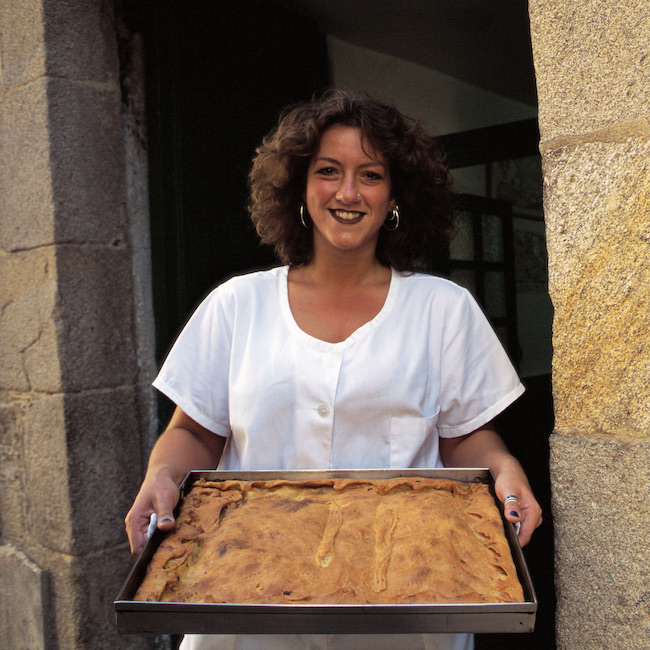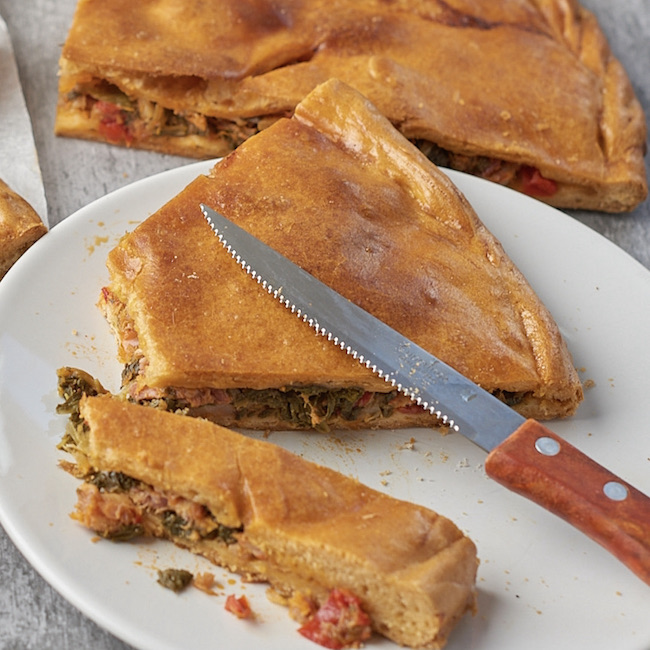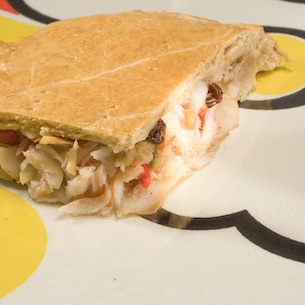- by John Barlow @John_Barlow_LS9
.png.transform/rendition-xs/image_image%20(1).png)
These simple savoury pasties, filled with fish, seafood or pork meat, are usually circular in form and about 20-30 centimetres in diameter and are perhaps the most widely consumed single product in Galicia

- by John Barlow @John_Barlow_LS9
Galician Empanadas are Big Stars: they are served at public celebrations, in bars and restaurants, and at home, you’ll find them in practically all bakeries. With fillings that reflect the land’s rich bounty of fish, seafood and meat, they’re an integral part of Galicia’s culture and identity.
The word itself probably derives from the verb empanar, ‘to encase in bread’ (pan). In Arabian cuisine pockets of wheat pastry filled with lamb—fatays and sfihas—have been popular for well over a millennium, and the long Arabian presence in Spain may have been responsible for introducing the idea of the empanada here.

The Way…
In the past, travelling across Galicia’s tortuous terrain would have meant carrying one’s meal in a convenient, all-in-one package to protect it from the dust and dirt. A kind of ancient tupperware. As such, Galician empanada really came into its own on the Road to Santiago. Pilgrims trekking hundreds of miles to the holy shrine of St James would have needed plenty of portable carbs, and there’s little doubt that empanadas would have been sold at many hostelries along the way.
When you finally get to Santiago Cathedral, just look up at the majestic 12th-century Pórtico de la Gloria. Carved in the stone you’ll see a group of penitents, one of whom is trying desperately to eat an empanada, although the noose around the poor man’s neck prevents him from swallowing. For a Galician, torture indeed.
Outside and Inside
Empanada pastry is usually wheat-based, sometimes with added rye flour. A little yeast or sourdough, a splash of oil (more traditionally pig fat) and some cold water, and there you have it. Roll it quite thin and put another layer on top. Half an hour or so in a medium oven, brushed with an egg glaze part-way through. Traditionally, this would have been in a village’s communal oven, everyone’s empanadas identified with a bit of their own decorative pastry.
The big question, though, is the filling. This is generally prepared in advance as a sofrito and includes onions and peppers. Unlike varieties elsewhere, Galician empanada does not normally include tomato.

Fillings tend to reflect the traditional availability of raw products. In coastal areas fish or seafood were used, tuna being the most common, simply mixed with the sofrito. The port of Burela on the northern coast, home of one of the region’s biggest tuna fleets, boasts perhaps the most famous empanada de bonito in Galicia.
Cod is also popular, especially with sultanas, which was traditionally served during Lent. These empanadas have a small ‘stopper’ of pastry in the centre which is taken out periodically throughout baking and a little fat added to avoid the cod getting too dry.
Sardines are often used with a more complex sofrito called a zaragallada (onions, garlic, leek, parsley, paprika and sometimes tomatoes). A variety of more localised versions also exist. Eels (conger, lamprey) are traditional in the province of Lugo, where there are plenty of rivers, and ray fish up on the coast in Cedeira. Then there’s octopus, a perennial favourite. For real aficionados, the water in which the octopus is boiled can be used to make the pastry, giving it a hint of octopussy sweetness.
One favourite variation, especially in the Rias Baixas on the south-west coast, uses a pastry made from fine corn meal (and sometimes a little wheat or rye to bind). Corn, and before that millet, was a staple in Galicia long before wheat, so this is probably the oldest version. Typically filled with seafood (mussels, cockles, cuttlefish), the oils and juices soak deep into the pastry, turning it moist and suffusing it with the taste of the sea. For some Galicians, a corn empanada with cod and sultanas is as near you can get to perfection.

As for meat, raxo (diced pork) or zorza (spiced, diced pork) are popular, again with a simple sofrito. Then there are more localised varieties, such as rabbit flavoured with aniseed. But you really can use whatever you like. In the coastal village of Lorbé, near Ferrol, the Panaderia Lorbé boasts thirty different varieties, including cheese and chicharrones (pulled pork), and salmon with grelos (kale).
A modern alternative is to use puff pastry, especially for empanadillas, the smaller, hand-held version. And of course, a wide range of vegetarian and vegan empanadas are now available.
They Travel!
Empanada pastry is only lightly leavened, and retains its form and consistency for a few days. So, they travel surprisingly well. The Forno de Lugo bakery, for example, works late into the evenings and sends its Galician bread and empanadas to various points of sale in Spain overnight. As the company manager Héctor Ramos says, ‘due to our logistics we have the product for sale fresh in various parts of the peninsula every day, but made in a traditional way as only we in Galicia we know how.’
Meanwhile, the Acuña bakery in Pontevedra also delivers nationally, and can get an empanada to you in about 24 hours, which is well worth the wait: their star-seller, the classic tuna variety, is a real beauty, with a solid crust and copious, moist filling.
A Final Word
As Héctor Ramos from Forno de Lugo notes, thanks to the efficiency of modern delivery systems, ‘we can compete not only on quality but also on price with any basic foodstuff’. And that, essentially, is the key. Galician empanadas are an inexpensive luxury, a taste of a region’s genuinely popular heritage, and now available throughout Spain at the click of your mouse.